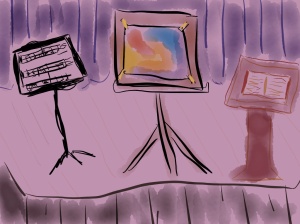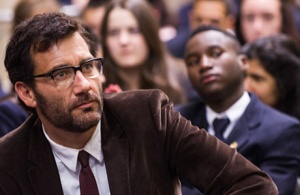Yesterday, I wrote a post about the film Words and Music, a sweet romance about a battle between an Art teacher and an English teacher. The film had interesting examples about the power of words and magnificent examples of the power of “pictures.” But what I forgot about was the part that held it together and in a way redeemed it:
The Power of Music
In the film. after the male protagonist has made a bollocks of things and the female protagonist has had enough of his destructive behavior, it is music that is the most evocative, most informative, most powerful…and most healing.
Scene after scene the male (Jack Marcus) tries to contact the female (Dina Delsanto) to apologize for the drunken mess he made of her art. Scene after scene we see her aggressively stop his attempts or stoically ignore them. Until the moment, when she opens an e-mail and there is an audio attachment. The piece–written for the film by Paul Grabowsky—is a chamber piece for piano, cello and clarinet entitled “I am a Small Poem.” (This is also the name of the poem that Markus steals from his son.) It is rich and resonant and connects with Delsanto more than any words or pictures could.
It is what saves their seemingly destroyed relationship.
I wish I could embed the music that was played when Delsanto opened her e-mail. but I can’t. It isn’t available yet. So instead, I will give you this: an extraordiary piece by Fauvre. It is what I often listen to when I am writing:
A while back, a music teacher (Manny DelPizzo), an art teacher (Jackie White) and I got together to make plans for a large project. (The educators call this kind of thing “Project Based Learning.”) I was going to get my Creative Writing Students to submit their best work and the art teacher and music teacher would each have their students interpret it and we would have a performance. Our ambitions were high–this seemed like the best outlet for student creativity– but the realities of schedules and time and curricula put many roadblocks in our way and we let it fizzle out.
The “performance” that the fictional students in Words and Pictures was much like what we were hoping for, minus the music. Our music component would have made it better.
A new school term is starting in a couple of weeks. I am newly energized (though not as drunken as Jack Marcus) and am excited about trying this for real. It doesn’t have to be a battle–as it was in the film–but a really cool examination of the power of words, of art, and of music–a real exercise in Creativity




